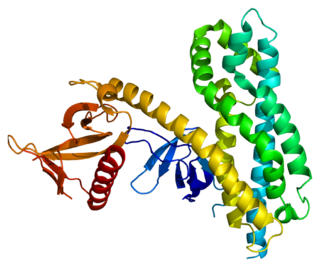
Dual specificity protein phosphatase 3 is an enzyme that in humans is encoded by the DUSP3 gene.

Leucine-rich repeats and immunoglobulin-like domains protein 1 is a protein that in humans is encoded by the LRIG1 gene. It encodes a transmembrane protein that has been shown to interact with receptor tyrosine kinases of the EGFR family and with MET and RET.

Non-imprinted in Prader-Willi/Angelman syndrome region protein 1 is a protein that in humans is encoded by the NIPA1 gene. This gene encodes a potential transmembrane protein which functions either as a receptor or transporter molecule, possibly as a magnesium transporter. This protein is thought to play a role in nervous system development and maintenance. Alternative splice variants have been described, but their biological nature has not been determined. Mutations in this gene have been associated with the human genetic disease autosomal dominant spastic paraplegia 6.

SET and MYND (myeloid-Nervy-DEAF-1) domain-containing protein 3 is a protein that in humans is encoded by the SMYD3 gene.

Shugoshin-like 2 , also known as SGOL2, is a protein which in humans is encoded by the SGOL2 gene.

Vacuolar-sorting protein SNF8 is a protein that in humans is encoded by the SNF8 gene.

Cytochrome b561 is a protein that in humans is encoded by the CYB561 gene.

Mitochondrial protein 18 kDa, also known as MTP18, is a human gene.

SLC35F6 is a protein that in humans is encoded by the SLC35F6 gene. The orthologue in mice is 4930471M23Rik.

Pseudouridylate synthase 7 homolog-like protein is an enzyme that in humans is encoded by the PUS7L gene.

SET and MYND domain-containing protein 4 is a protein that in humans is encoded by the SMYD4 gene.

Ninein-like protein is a protein that in humans is encoded by the NINL gene. It is part of the centrosome.

Rho guanine nucleotide exchange factor 4 is a protein that in humans is encoded by the ARHGEF4 gene.

DCC-interacting protein 13-beta is a protein that in humans is encoded by the APPL2 gene.

Phosphoribosyl pyrophosphate synthetase-associated protein 2 is a protein that in humans is encoded by the PRPSAP2 gene.

Coiled-coil domain-containing protein 57 is a protein that in humans is encoded by the CCDC57 gene.

Protein FAM134C is a protein that in humans is encoded by the FAM134C gene.

caprin family member 2, also known as CAPRIN2, is a human gene.

Mitochondrial methionyl-tRNA formyltransferase is a protein that in humans is encoded by the MTFMT gene.

Eukaryotic translation initiation factor 4E family member 3 is a protein that in humans is encoded by the EIF4E3 gene.















